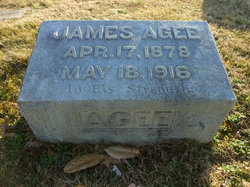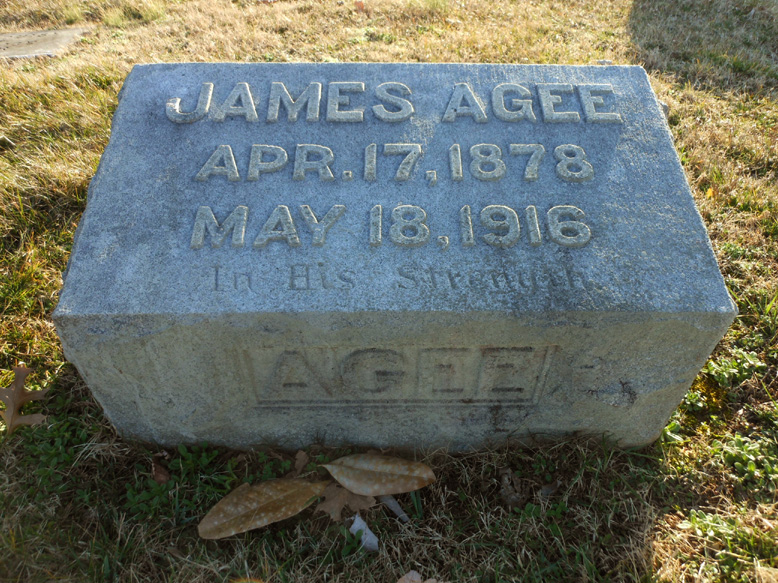Last year, Knoxville celebrated the centennial of a treasured moment in author James Agee's life, one he preserved in "Knoxville: Summer of 1915." In his most locally recognized work, Agee describes Highland Avenue, the middle-class neighborhood in which he lived, evoking the simple pleasures of an evening surrounded by his family and the joys of childhood before there was a care in the world.
It was the last such summer for James Agee. Less than a year later, his father was killed in a car accident. Many people believe the event is what led Agee, who was 6 years old and called Rufus at the time, to later pursue a writing career. The tragedy would have been lost to history had Agee not retold it in his acclaimed novel.
We are talking now of that particular night, 100 years ago, when Agee's life changed forever.
Jay was 38, husband of Laura, father of Rufus and Emma, employed as a bookkeeper at his father-in-law's factory. On the night of May 18, 1916, he was driving back to Knoxville. He was exhausted, running on little sleep since he'd been called up to Jacksboro late the previous night. His father, a farmer and former schoolteacher, had suffered a stroke and was ailing to the point that Jay planned to pick up his family and return to Campbell County with them in what could be his kids' last chance to see their grandfather.
Today, the journey from Jacksboro to downtown Knoxville takes about 45 minutes. But in 1916, the most direct route connected those two cities through Caryville, Coal Creek, and Clinton. He did save time when he reached Clinton, where a new bridge had opened two weeks prior, ending the ferry service. But with his Model T averaging 20 mph over narrow gravel roads in various states of maintenance, Jay's trip home took close to three hours.
Of course, he never made it. He was on the last and easiest leg of his southbound journey, 13 miles outside of Knoxville, when something went wrong. The cause of the accident could only be speculated. Those examining the wreck concluded that Jay had been speeding and hit a stone or a rough patch of road, which suddenly jerked his wheels aside. As the car hit the embankment, Jay's chin smacked hard against the steering wheel. Doctors guessed he was already dead when he fell from the car, which landed on top of him.
While writing his fact-based novel about the accident, James Agee misnamed the road (Clinton Pike) as Ball Camp Pike. But he got other details right. Seconds before the wreck, his father had crossed Beaver Creek over an iron bridge, which Agee correctly identified as Bell's Bridge. Built in 1888 and named after a local family, the structure was replaced with a new concrete bridge around 1930 as part of the straighter and wider Clinton Highway. Although the former bridge is gone, brush-covered stone abutments still mark the spot where it stood. The north abutment sits against the creek bank directly behind Weigel's on Clinton Highway in Powell.
Agee also wrote that his father's body was carried off the road and laid in a blacksmith shop until family members arrived at the scene. There was indeed a shop nearby, owned by William Dew, who for decades operated a grain mill along the south bank of the creek. Up until about 15 years ago, the former Dew cottage still sat off the west side of the highway, engulfed in kudzu. The night Jay died, city doctors might have been called from that very house.
Little remains in the area that Jay would have recognized. The closest surviving pre-1916 house to the crash site is a two-story Victorian, currently known as Lulu's Tea Room, located a few hundred yards south on Old Clinton Pike.
Ten years after the accident, Rufus was a New England prep school student answering to James or Jim and longing to write about his father's death. Although he wouldn't write explicitly about the tragedy for decades, Agee's early fiction is saturated with references to a deceased parent or spouse and sudden, life-altering occurrences.
After a brief and varied writing career that included poetry, journalism, screenplays and fiction, James Agee died of a heart attack in New York on May 16, 1955. He was 45. "A Death in the Family" was published two years later and promptly won the 1958 Pulitzer for fiction. The novel stands as a moving tribute to a part of Agee's life that he lost in Knoxville and never recovered.
Paul F. Brown is currently writing "Rufus: James Agee's Roots in Eastern Tennessee." He is looking for pre-1940 photographs of the Bells Bridge area of Powell and may be emailed at [email protected]."
(info provided by Chris #47832597)
Last year, Knoxville celebrated the centennial of a treasured moment in author James Agee's life, one he preserved in "Knoxville: Summer of 1915." In his most locally recognized work, Agee describes Highland Avenue, the middle-class neighborhood in which he lived, evoking the simple pleasures of an evening surrounded by his family and the joys of childhood before there was a care in the world.
It was the last such summer for James Agee. Less than a year later, his father was killed in a car accident. Many people believe the event is what led Agee, who was 6 years old and called Rufus at the time, to later pursue a writing career. The tragedy would have been lost to history had Agee not retold it in his acclaimed novel.
We are talking now of that particular night, 100 years ago, when Agee's life changed forever.
Jay was 38, husband of Laura, father of Rufus and Emma, employed as a bookkeeper at his father-in-law's factory. On the night of May 18, 1916, he was driving back to Knoxville. He was exhausted, running on little sleep since he'd been called up to Jacksboro late the previous night. His father, a farmer and former schoolteacher, had suffered a stroke and was ailing to the point that Jay planned to pick up his family and return to Campbell County with them in what could be his kids' last chance to see their grandfather.
Today, the journey from Jacksboro to downtown Knoxville takes about 45 minutes. But in 1916, the most direct route connected those two cities through Caryville, Coal Creek, and Clinton. He did save time when he reached Clinton, where a new bridge had opened two weeks prior, ending the ferry service. But with his Model T averaging 20 mph over narrow gravel roads in various states of maintenance, Jay's trip home took close to three hours.
Of course, he never made it. He was on the last and easiest leg of his southbound journey, 13 miles outside of Knoxville, when something went wrong. The cause of the accident could only be speculated. Those examining the wreck concluded that Jay had been speeding and hit a stone or a rough patch of road, which suddenly jerked his wheels aside. As the car hit the embankment, Jay's chin smacked hard against the steering wheel. Doctors guessed he was already dead when he fell from the car, which landed on top of him.
While writing his fact-based novel about the accident, James Agee misnamed the road (Clinton Pike) as Ball Camp Pike. But he got other details right. Seconds before the wreck, his father had crossed Beaver Creek over an iron bridge, which Agee correctly identified as Bell's Bridge. Built in 1888 and named after a local family, the structure was replaced with a new concrete bridge around 1930 as part of the straighter and wider Clinton Highway. Although the former bridge is gone, brush-covered stone abutments still mark the spot where it stood. The north abutment sits against the creek bank directly behind Weigel's on Clinton Highway in Powell.
Agee also wrote that his father's body was carried off the road and laid in a blacksmith shop until family members arrived at the scene. There was indeed a shop nearby, owned by William Dew, who for decades operated a grain mill along the south bank of the creek. Up until about 15 years ago, the former Dew cottage still sat off the west side of the highway, engulfed in kudzu. The night Jay died, city doctors might have been called from that very house.
Little remains in the area that Jay would have recognized. The closest surviving pre-1916 house to the crash site is a two-story Victorian, currently known as Lulu's Tea Room, located a few hundred yards south on Old Clinton Pike.
Ten years after the accident, Rufus was a New England prep school student answering to James or Jim and longing to write about his father's death. Although he wouldn't write explicitly about the tragedy for decades, Agee's early fiction is saturated with references to a deceased parent or spouse and sudden, life-altering occurrences.
After a brief and varied writing career that included poetry, journalism, screenplays and fiction, James Agee died of a heart attack in New York on May 16, 1955. He was 45. "A Death in the Family" was published two years later and promptly won the 1958 Pulitzer for fiction. The novel stands as a moving tribute to a part of Agee's life that he lost in Knoxville and never recovered.
Paul F. Brown is currently writing "Rufus: James Agee's Roots in Eastern Tennessee." He is looking for pre-1940 photographs of the Bells Bridge area of Powell and may be emailed at [email protected]."
(info provided by Chris #47832597)
Inscription
In His Strength
Family Members
Sponsored by Ancestry
Advertisement
Explore more
Sponsored by Ancestry
Advertisement






